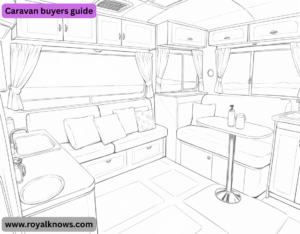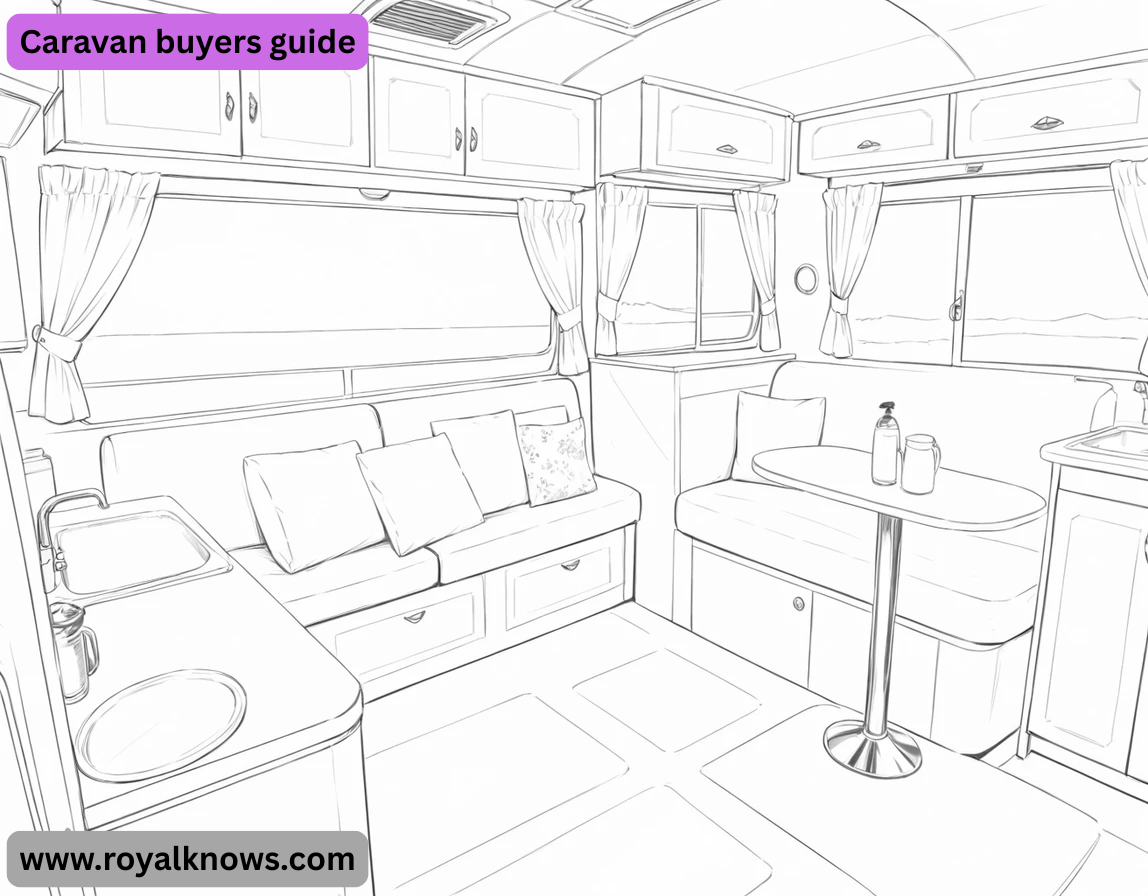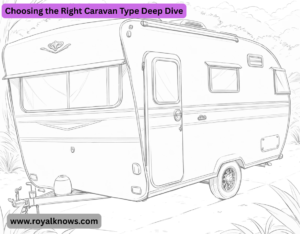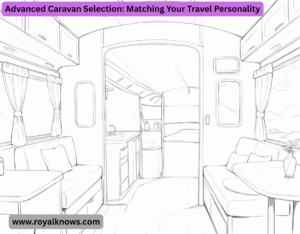Caravan buyers guide Buying a caravan is a big investment, whether you’re a first-time buyer or upgrading your current model.

1. Determine Your Needs & Budget
- Before shopping, ask yourself:
- Who will be using the caravan? (Couples, families, solo travelers?)
- How often will you travel? (Weekends, long trips, full-time living?)
- What’s your towing vehicle? (Check weight limits—more on this below.)
- What’s your budget? (New vs. used, financing options.)
3. Weight & Towing Capacity
- ATM (Aggregate Trailer Mass): Max weight of the loaded caravan.
- Tare Weight: Unladen weight of the caravan.
- Payload: Difference between ATM and Tare (luggage, water, supplies).
- Rule of thumb: Your caravan’s ATM should be ≤ 85-90% of your car’s towing limit for safe handling.
4. Layout & Features
Consider:
- Sleeping arrangements (Fixed beds vs. convertible dinettes)
- Kitchen facilities (Stove, fridge, sink size)
- Bathroom (Ensuite vs. shared campground facilities)
- Storage (Under-bed, overhead, external compartments)
- Power & Water (12V, 240V, gas, freshwater & wastewater tanks)
6. Essential Checks Before Buying
- Inspect the chassis & suspension (rust, cracks)
- Check seals & insulation (look for leaks/mold)
- Test all appliances (fridge, stove, heating)
- Verify compliance & registration (REVS check for encumbrances)
7. Financing & Insurance
- Loan options: Secured vs. unsecured loans (compare interest rates).
- Insurance: Comprehensive cover for accidents, theft, and damage.
Choosing the Right Caravan Type Deep Dive
- A. Pop-Top Caravans
Pros: - Lighter, better fuel efficiency (reduced wind drag).
- Easier to store (fits in standard garages).
Cons:
- Less insulation (not ideal for extreme weather).
- Smaller living space (roof lowers when parked).
B. Full-Height Caravans
- Best for: Families, long-term travelers, all-season use.
Pros:
- More headroom, spacious interiors.
- Better insulation (for hot & cold climates).
Cons:
- Higher fuel consumption (greater wind resistance).
- Harder to store (may need a taller garage).
C. Off-Road Caravans
- Best for: Adventurers, outback trips, rough terrain.
Pros:
- Reinforced chassis & suspension.
- Higher ground clearance (avoid rocks & ruts).
Cons:
- Expensive (premium build quality).
- Heavier (requires a powerful 4WD).
D. Hybrid (Camper Trailers)
- Best for: Budget buyers, occasional campers.
Pros:
- Lightweight, easy to tow.
- Cheaper than full caravans.
Cons:
- Less comfort (often no built-in bathroom).
- Takes longer to set up.
E. Fifth Wheelers
- Best for: Full-time living, luxury travelers.
Pros:
- Massive space (like a small apartment).
- Stable towing (attaches to a truck bed).
Cons:
- Needs a heavy-duty pickup truck.
- Expensive (both caravan & tow vehicle).
2. Towing Capacity & Weight Calculations (Critical!)
- A. Know Your Car’s Limits
- Check your vehicle manual for:
- Maximum Towing Capacity (e.g., 2,500kg).
- Ball Weight Limit (usually 10% of caravan weight).
- Example: If your caravan’s ATM is 2,000kg, your car must handle at least 2,200kg (with safety buffer).
7. Final Checklist Before Buying
- Take a test tow (check handling & stability).
- Negotiate extras (free awning, solar panels).
- Read reviews (Facebook groups, caravan forums).
- Plan storage (secure, covered if possible).
1. Advanced Caravan Selection: Matching Your Travel Personality
- A. The Weekend Warrior
- For those who escape Fridays after work:
- Best Type: Lightweight pop-top or hybrid
Key Features:
- Quick setup (under 10 minutes)
- Basic kitchen (2-burner + 60L fridge)
- Minimal storage (just weekend gear)
B. The Snowy Mountains Nomad
- For winter adventurers:
- Best Type: Full-height with Arctic Pack
Must Haves:
- Double-glazed windows
- Truma heating system
- Enclosed undercarriage
C. The Outback Explorer
- For remote desert travel:
- Critical Features:
- 150L+ water capacity
- Dual battery system (300Ah+)
- Heavy-duty stone guard
D. The Luxury Glamper
- For resort-style comfort:
- Worth the Splurge:
- Full ensuite with washing machine
- 190L compressor fridge
- Outdoor entertainment system
2. Towing Dynamics: The Physics You Need to Know
- A. Weight Distribution Secrets
- Weighbridge Test: Essential before first big trip
- Load Sequencing: Heaviest items low and forward
3. Must-Have Features (What to Look For)
A. Essential Features
- Strong Chassis (Galvanized steel resists rust).
- Independent Suspension (Better for off-road).
- Adequate Water Storage (100L+ for remote trips).
- Solar Power Option (For off-grid camping).
B. Comfort & Convenience
- Fixed Bed vs. Convertible Dinette
- Fixed Bed: More comfortable but takes space.
- Dinette: Saves space but less comfy for long trips.
- Kitchen Setup
- 2-burner stove vs. 4-burner (More burners = better for families).
- Fridge Size (80L+ for long trips).
Bathroom Options
- Ensuite (Convenient but takes space).
- Shared Amenities (Saves weight if using campgrounds).
Used Caravan Checklist:
- Check for water damage (soft walls, musty smell).
- Inspect tyres & suspension (cracks, rust).
- Test all appliances (fridge, stove, lights).
- Verify service history & registration.
5. Hidden Costs & Extra Expenses
- Many buyers forget these additional costs:
- Tow bar installation (500–500–1,500).Caravan insurance (800–800–2,000/year).
- Registration & roadworthy checks ($500+/year).
- Accessories (awning, solar panels, stabilizers).
C. Aerodynamics & Fuel Economy
- Wind Deflectors can improve economy by 8-12%
- Roof Loads (like kayaks) increase drag dramatically
B. Kitchen Work Triangles
- Efficient Design: Fridge ≤ 1.2m from cooktop
- Galley vs. L-Shaped: Galley better for cooking, L-shaped better for space
C. Bathroom Trade-Offs
- Full Ensuite: Adds ~300kg but priceless at 3AM
- Wet Bath: Saves space but everything gets wet
4. Seasonal Considerations: Buying Smart
- A. Best Time to Buy
- New Models: Released August-October
- Best Deals: February-April (dealers clearing stock)
B. Climate-Specific Features
- Climate Essential Features
- Tropical Maxi-vent fans, mesh screens
- Alpine Heated tanks, thermal pack
- Arid Dust seals, solar upgrades
C. Storage Solutions
- Summer: Ventilated, off-ground
- Winter: Moisture absorbers, rodent protection
B. What to Always Ask For
- Free first service
- Extended warranty
- Delivery to your location
C. Red Flags in Dealers
- Won’t let you inspect the chassis
- Pushy financing offers
- Vague answers about weights
6. The 7-Point Pre-Delivery Inspection
- Chassis & Undercarriage
- Look for uneven rust patterns
- Seal Integrity
- Appliance Testing
- Run fridge for 4+ hours before accepting
Water System Check
- Pressurize for 30 minutes looking for drips
Electrical Systems
- Test every 12V and 240V outlet
- Gas Compliance
- Demand current gas certificate
- Final Weight Check
- Get dealer to certify actual Tare weight
7. The First 1000km: Break-In Protocol
- First 200km: Stay below 80km/h
- Every 200km: Check wheel nut torque
- After 500km: Re-tension all straps
- At 1000km: Full suspension check
Precision Weight Management
- The 85% Myth Debunked: Why experienced towers safely exceed this with proper setup
- Weighbridge Techniques: How to properly load for a perfect 8-12% ball weight
- Advanced Weight Distribution: Using portable scales for each corner balance
Towing Vehicle Optimization
- Suspension Upgrades: Airbag vs coil vs leaf spring enhancements
- Transmission Cooling: Essential for automatic vehicles
- Mirror Mathematics: Calculating required field of view based on caravan width
Masterclass 2: The Technical Buyer’s Inspection
- Chassis Forensics
- Galvanizing Assessment: How to spot inferior coating applications
- Welding Analysis: Identifying quality vs. problematic joins
- Corrosion Hotspots: The 7 hidden areas that always rust first
…….Caravan buyers guide…….


